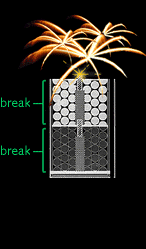![]()
The construction of aerial shells is crucial to the success of the fireworks display. Each shell is made in a controlled environment, taking all the necessary steps for safety and the prevention of a large scale disaster. DO NOT TRY THIS AT HOME! The construction of aerial shells that produce the large star effects are fired from ground mortars. The construction of the shell must be consistent and accurate. If a shell gets stuck in a mortar tube and never leaves the ground, a potential mass explosion could cause a chain reaction with the near by shells. If a shell is out of balance or the lifting charge is inadequate, the shell could stray from the desired trajectory and, again, cause a safety hazard.






The construction of the Oriental style shell and the American cylinder shell has been perfected over the past 30 years. These two shell designs are the primary style constructed and used world wide. The Oriental sphere shells are similar to the small 1” shells that can be purchase at any good Fireworks stand. The American cylinder shell can be thought of as a large bottle-rocket without the shaft. The basic components of a shell consist of a lifting charge, time fuse, burst charge, and effects/stars. Also, the 2-Break and Report shell is a variant of the American cylinder shell (common).
The first step in creating an Oriental style shell is to make a spherical form. Then place a thin layer of plastic in the form so the shell paper does not get stuck when the process is complete. Next, apply the shell material around to the form; most commonly used is newspaper. This step can be thought of as paper mache to create the shape and exterior shell wall. The larger the shell, the more layers of newspaper required. Heat shell and form in oven for about three hours or until completely dry. Cut shell in half; must be exact. The shell can now be loaded with the burst stars and pasted back together for firing. The lifting charge is then created and pasted to the bottom of the shell. DO NOT TRY THIS AT HOME!

Below are the basic components of a firework:
Launching Tube
Most fireworks are launched from rows of steel tubes or PVD tubes which are secured in troughs of sand or secured to the bases of the trough. The length of the tube is three time as long as the diameter of the shell. The shell should not fit loosely or over tightly into the tube. A loose shell will lose the pressure created from the lifting charge and the shells will not lift out of the tube.
.gif)
.jpg)
Lift Charge
When gunpowder burns in the open air, the heat and gas it generates quickly
dissipates. But if the gunpowder is confined, say in a pouch at the bottom
of a firework cylinder, the heat and gas are trapped and will push wildly
at the inside of the launch tube until an explosion results. This explosion
will free the heat and gas, and hurtle the firework shell as high as 1000
feet into the air.
Time Delay Fuse
As the firework shoots through the air, the time-delay fuse continues to burn. When the shell is close to its apex, the fuse has burned low enough to ignite the black powder in the first break (or compartment). Colored stars ignite and are launched in every direction as the fuse ignites the black powder in the second and third break. Timing is critical. In a three-break firework, the middle break needs to ignite at the highest point in the shell's trajectory -- the first break should blow a little before and the third break, a little after. If the timing is off, the firework might detonate too close to the ground. Great care is used in designing the fuses and calculating their lengths.
Breaks
In a multi-break firework, stars are contained in separate cardboard compartments within the shell. Each container has its own bursting charge which lights and throws out the stars. In order to spread these decorations over a wide area of the sky, the container must burst open with tremendous force. The more the container can resist the explosion and bottle up its force, the bigger the display will be. Resistance comes from the container's heavy wrapping, which is designed to momentarily trap the gas and heat from the bursting charge.



[Home][History][Physics][Chemistry][Personal Experience][Bibliography]